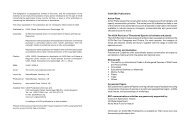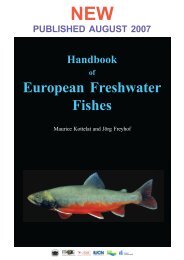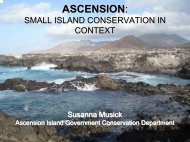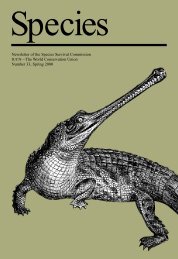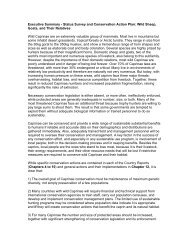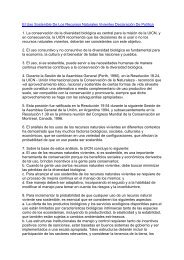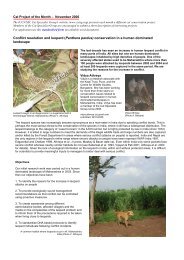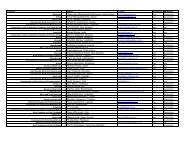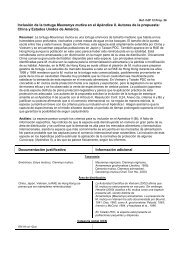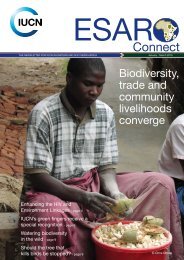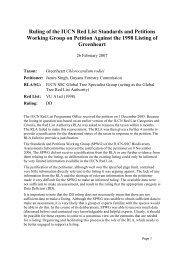Planning education to care for the earth - IUCN Knowledge Network
Planning education to care for the earth - IUCN Knowledge Network
Planning education to care for the earth - IUCN Knowledge Network
You also want an ePaper? Increase the reach of your titles
YUMPU automatically turns print PDFs into web optimized ePapers that Google loves.
<strong>Planning</strong> <strong>education</strong> <strong>to</strong> <strong>care</strong> <strong>for</strong> <strong>the</strong> <strong>earth</strong>•<strong>to</strong> apply <strong>the</strong> programme in all parts of western Africa where <strong>IUCN</strong>is present;•<strong>to</strong> share in<strong>for</strong>mation and experience among <strong>the</strong> different partners inenvironmental <strong>education</strong> in <strong>the</strong> region in order <strong>to</strong> create a Saheliandata bank;•<strong>to</strong> develop among <strong>the</strong> people in each country a sense of belonging <strong>to</strong><strong>the</strong> Sahel as an encouragement <strong>to</strong> common action;•<strong>to</strong> train teachers <strong>to</strong> pass on <strong>the</strong>ir knowledge <strong>to</strong> <strong>the</strong> community.The first project in <strong>the</strong> Sahel was Walia, in Mali, which has becomeemblematic of <strong>the</strong> <strong>IUCN</strong> environmental <strong>education</strong> programme throughoutwestern Africa. Named after <strong>the</strong> migra<strong>to</strong>ry s<strong>to</strong>rk which heralds <strong>the</strong> arrivalof rains and good harvests, Walia is an <strong>education</strong>al programmespearheaded by a 24-page magazine published three times a year. Themagazine has a specific readership: secondary school pupils from 13 <strong>to</strong> 18years of age. The magazine is <strong>care</strong>fully and logically planned; subjectmatter reflects <strong>the</strong> immediate surroundings of readers and each issue isdevoted <strong>to</strong> a single major <strong>to</strong>pic - wetlands, arid zones, water, trees, etc.Great attention is paid <strong>to</strong> pupils' and teachers' suggestions. This, plus <strong>the</strong>familiar <strong>for</strong>m of address, involve directly <strong>the</strong> reader and create a sense ofcloseness and a need <strong>to</strong> react.When <strong>the</strong> magazine has been distributed, all schools taking part in <strong>the</strong>programme receive a follow-up visit from <strong>the</strong> publishing team <strong>to</strong> develop<strong>the</strong> <strong>the</strong>mes and challenge students <strong>to</strong> speak up and <strong>to</strong> think about solutions.Students interview key people in <strong>the</strong> community <strong>to</strong> collect in<strong>for</strong>mation, andthus learn more about traditions, tales, legends, environmental managementin previous times, and past and present rural practices. Once this in<strong>for</strong>mationis collected it is possible <strong>to</strong> start discussions on potential actions. Maps andpanels illustrating <strong>the</strong> current <strong>the</strong>me are also used <strong>to</strong> engage students indiscussions.These follow-up sessions take place outside <strong>the</strong> school scheduleor during biology classes and students attend of <strong>the</strong>ir own free will. (It hasbeen observed that young people taking part regularly in environmental<strong>education</strong> programmes not only become more involved in communityactivities, but are also more successful in school).Students are encouraged <strong>to</strong> make surveys and organize contests. Studentsurveys, <strong>to</strong>ge<strong>the</strong>r with letters, help <strong>to</strong> define <strong>to</strong>pics <strong>to</strong> be dealt with in futureissues of <strong>the</strong> magazine. The magazine is very often <strong>the</strong> only writtendocument in a school and becomes a valued teaching aid.Walia clubs provide young, motivated readers of <strong>the</strong> magazine with <strong>the</strong>opportunity <strong>to</strong> “do something”. Teachers help <strong>the</strong>m <strong>to</strong> find local partners <strong>for</strong>a practical activity. Guinea worm disease (dracunculiasis) was eradicated ineight villages in <strong>the</strong> Dogon country of Mali after a campaign by youngpeople on <strong>the</strong> importance of filtering drinking water. They were supported by<strong>the</strong> traditional authorities. Ano<strong>the</strong>r example of youth activity from a villagein <strong>the</strong> Dogon country was <strong>the</strong> destruction of egg sacs of locusts. Adult76



